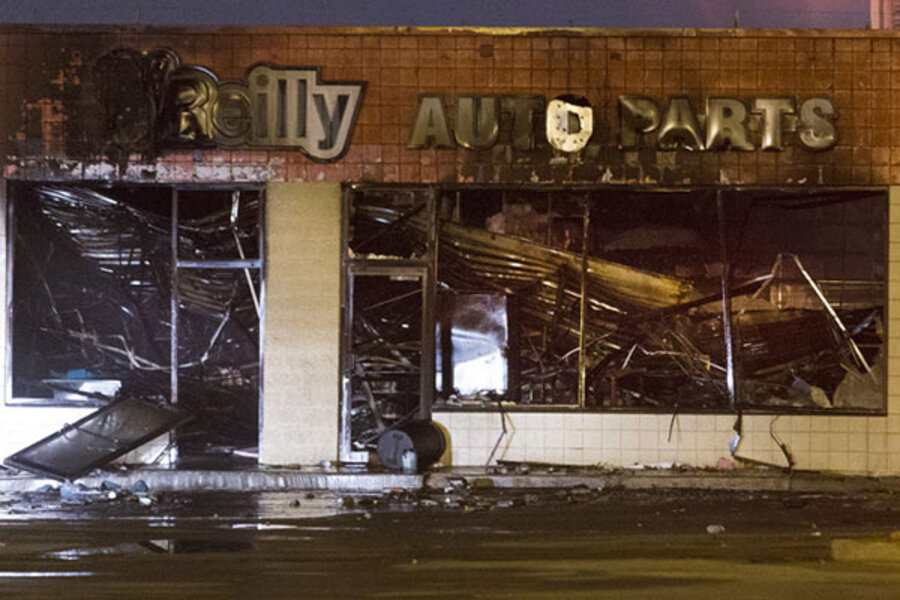Milwaukee picks up pieces after night of violence
Loading...
Volunteers swept and picked up debris Sunday in a north Milwaukee neighborhood that was rocked by hours of late night violent unrest sparked by a police officer's shooting of a man fleeing a traffic stop.
Up to three dozen people swept up glass and filled trash bags with rocks, bricks and bottles at an intersection where a BP gas station burned to the ground, a traffic light was bent and bus shelters were shoved to the ground Saturday night. One volunteer picked up a bullet casing and handed it to police.
Darlene Rose, 31, said she understands the anger that fueled the violence, but that it doesn't help.
"I feel like if you're going to make a difference, it's got to be an organized difference," Rose said. "The people that came and looted, you're not going to see them here today."
The event that triggered the violence was the Saturday afternoon shooting by a police officer of a man authorities said was armed and who fled a traffic stop. It wasn't clear if the man aimed the gun at officers.
Authorities have not released the names or races of the man who was killed nor the officer who shot him.
Three protesters were arrested, and one officer was injured by a thrown brick. At a late night news conference at which city leaders appealed for calm, Mayor Tom Barrett said the man was hit twice, in the chest and arm.
The protesters were largely black, and Alderman Khalif Rainey — who represents the district — said early Sunday that the city's black residents are "tired of living under this oppression." Nearly 40 percent of Milwaukee's 600,000 residents are black, and heavily concentrated on the north side.
"Now this is a warning cry. Where do we go from here? Where do we go as a community from here?" Rainey said at the news conference with Barrett.
The anger at shootings by Milwaukee police is not new, and comes as tension between black communities and law enforcement has ramped up across the nation, resulting in protests and the recent killings of officers in Baton Rouge, Louisiana, and Dallas.
Milwaukee was beset by protests and calls for police reform after an officer fatally shot Dontre Hamilton, a mentally ill black man, in 2014. In December, the Justice Department announced it would work with Milwaukee police on reforms. Chief Ed Flynn had asked for what's known as a collaborative reform process after the federal government said it wouldn't pursue criminal civil rights charges against the officer.
Critics said the department should have submitted to a review of its patterns and practices, as was conducted in Ferguson, Missouri, after the fatal shooting of 18-year-old Michael Brown, who was black, by a white police officer in 2014.
The state is investigating the latest shooting in Milwaukee. Barrett said the officer was wearing a body camera.
Barrett said police stopped the 23-year-old man who died for "suspicious activity." Police said he was carrying a gun that had been stolen in a March burglary in suburban Waukesha.
"This stop took place because two officers ... saw suspicious activity," the mayor said. "There were 23 rounds in that gun that that officer was staring at. I want to make sure we don't lose any police officers in this community, either."
Around 100 protesters massed at 44th Street and Auer Avenue between 8 and 9 p.m., surging against a line of 20 to 30 officers. The Milwaukee Journal Sentinel reported that officers got in their cars to leave at one point and some in the crowd started smashing a squad car's windows. Another police car was set on fire. The newspaper reported that one of its reporters was shoved to the ground and punched.
Around 11 p.m., police with shields and helmets moved slowly into the intersection, telling a crowd of about 50 people to disperse. Some threw rocks and debris at police, who held up their shields. People in the crowd also threw objects at a business a half-block from the intersection. A nearby traffic light was bent over and bus shelters overturned.
A bank, a gas station, an auto parts store and a beauty supplies shop were burned in the violence. Firefighters held back from the gas station blaze because of gunshots.
Police said the man who was shot had an arrest record. The 24-year-old officer who shot the man has been placed on administrative duty. The officer has been with the Milwaukee department six years, three as an officer.
Just blocks away from the riots, two people were shot and killed Friday and Saturday, bringing to five the number of people who died in shootings in the city during a nine-hour stretch.
"As everyone knows, this was a very, very violent 24 hours in the city of Milwaukee," Assistant Chief Bill Jessup told the Journal Sentinel. "Our officers are out here taking risks on behalf of the community and making split-second decisions."





